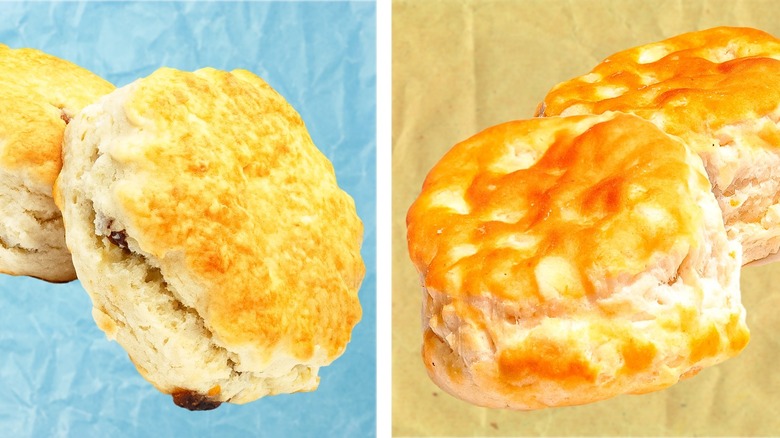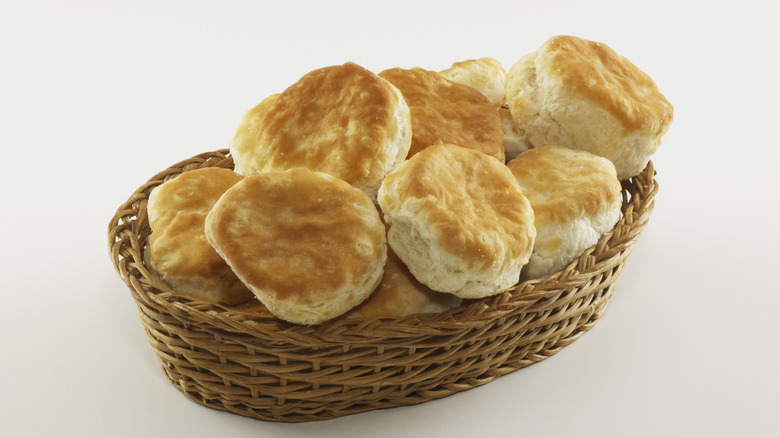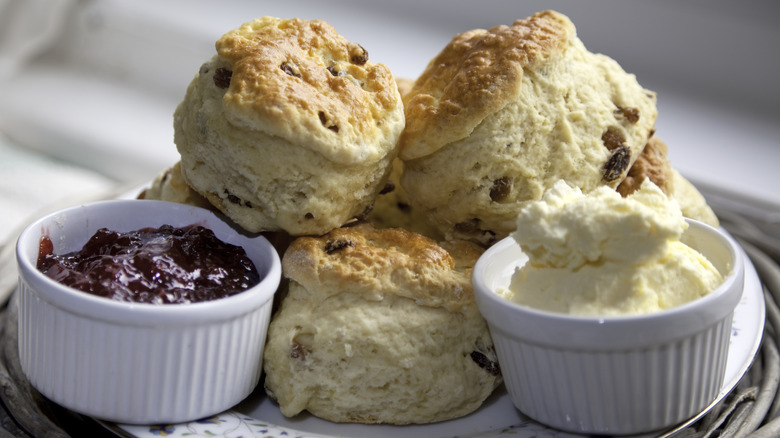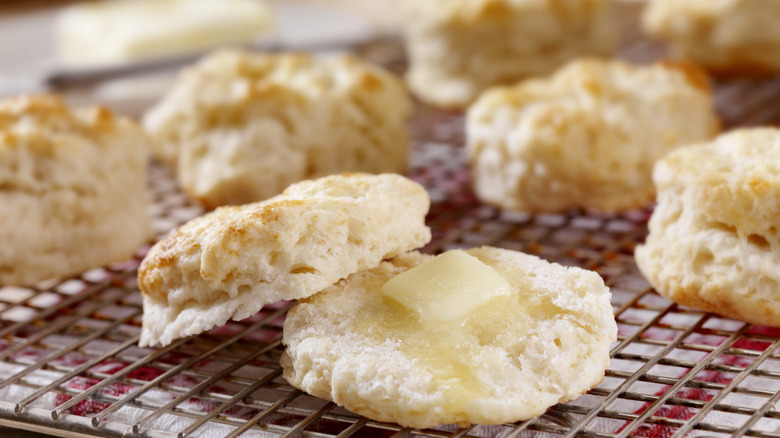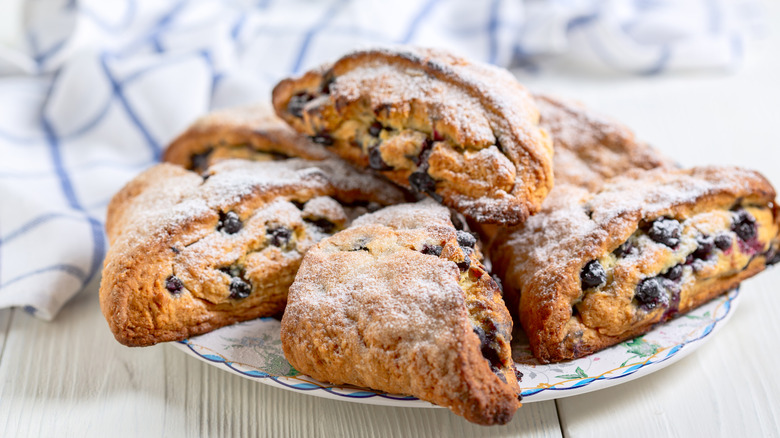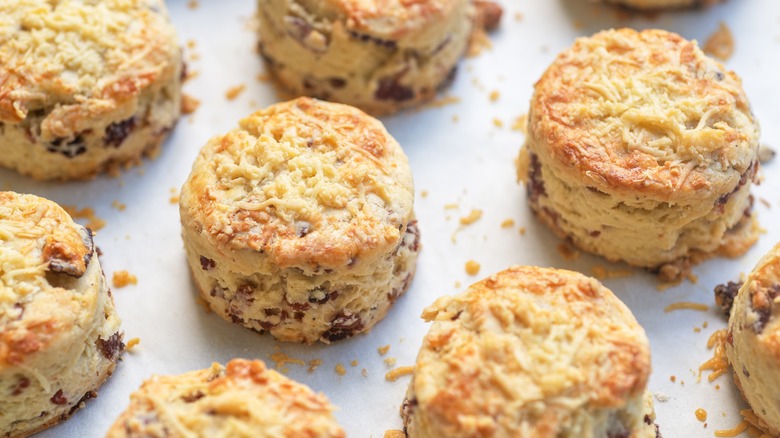The Real Difference Between Biscuits And Scones
Biscuits and scones, both beloved baked goods, share some similarities but also have distinct differences. However, unless you are an avid baker, you might not be able to readily spot the distinctions between the two. Let's take a closer look at what sets each apart.
Biscuits, the fluffy Southern staple, are typically made from a simple mixture of dry and wet ingredients. They are known for their flaky, tender interior and golden, slightly crispy exterior. Biscuits are often savory, served with butter, gravy, or alongside hearty meals, making them a staple of Southern comfort food.
On the other hand, scones are a bit more elaborate, with a similar foundation of wet and dry ingredients often with the addition of sugar. Scones have a sweeter, denser texture compared to biscuits and can be flavored with ingredients like dried fruits, chocolate chips, or herbs. They are frequently sweetened with sugar and sometimes feature glazes or drizzles. Scones are a classic component of English afternoon tea, accompanied by clotted cream and jam. While both biscuits and scones are delicious baked treats, their distinct ingredients and purposes set them apart. Let's explore the key differences between the two.
What are biscuits?
Southern biscuits are a beloved culinary treasure, deeply rooted in the culinary traditions of the American South. These delectable baked goods trace their origins back to early European settlers who brought their baking techniques to the southern United States.
Key ingredients in a classic Southern biscuit include all-purpose flour, baking powder, salt, fat (usually butter, lard, or shortening), and buttermilk. The magic happens when these ingredients are combined and baked to golden perfection. Southern biscuits are renowned for their rich, buttery flavor, and they have a tender, flaky interior encased in a beautifully browned, slightly crispy crust on top.
The layers of a well-made biscuit are as light as air, practically begging to be split open and generously slathered with butter, gravy, honey, or jam. Whether served at breakfast, as a side dish, or even as a vehicle for sandwiches, Southern biscuits are a cherished staple in Southern cuisine, celebrated for their simplicity, versatility, and irresistible taste and texture.
What are scones?
Scones, hailing from the British Isles, are a delightful baked treat known for their rustic charm and timeless appeal. These humble pastries trace their origins back to Scotland, where they were first created in the 16th century. Today, you can easily find English scones in most bakeries in the United Kingdom — and abroad.
Key ingredients in traditional scones include all-purpose flour, sugar, baking powder, butter, eggs, and milk or cream. The beauty of scones lies in their versatility, as they can be sweet or savory, depending on the addition of ingredients like dried fruits, nuts, chocolate chips, or cheese. Scones boast a delicate balance of flavors, with a slightly sweet, buttery taste that pairs wonderfully with a cup of tea or coffee.
In terms of texture, they are characterized by a crumbly and tender interior, while the exterior often has a golden-brown, lightly crispy crust. Served warm, with a dollop of clotted cream and a spoonful of jam. Whether enjoyed as a morning indulgence or an afternoon delight, scones continue to captivate taste buds around the world with their simple yet irresistible charm.
Biscuits are made with plenty of butter
One of the most important differences between biscuits and scones is at the heart of what sets these two beloved baked goods apart. Biscuits, particularly the fluffy variety, are characterized by their rich, buttery flavor and tender, flaky texture. This indulgent quality is achieved through the generous use of butter. The butter is typically cut into the flour, creating layers as it melts during baking, resulting in the signature flakiness of a biscuit.
Conversely, scones follow a different approach, more akin to a quick bread than the buttery indulgence of biscuits. While butter is still sometimes a player in scone dough, its role is less prominent than in biscuits, resulting in a different texture. This variance in ingredient proportions leads to the distinct differences in flavor and texture between these two delightful baked goods, making biscuits a buttery indulgence and scones a more versatile, tender treat.
Scones have a crumbly texture
The distinctive textural difference between biscuits and scones is a testament to the role of fat — as well as the dry-to-liquid ingredient ratio — in their respective recipes. This remarkable, fluffy texture of biscuits is attributed to the abundant use of butter, meticulously integrated into the dough. As biscuits bake, the butter melts, creating pockets of steam within the layers, resulting in that sought-after flakiness. The presence of ample fat yields a soft, moist, and delicately crumbly interior that is the hallmark of a perfect biscuit.
In contrast, scones exhibit a dry, crumbly texture owing to their relatively lower fat content compared to biscuits. This modest use of fat, paired with a higher dry-to-wet ingredient ratio, translates to less moisture and fewer fat layers within the dough, yielding a crumbly, somewhat denser interior. The drier texture of scones not only makes them an ideal canvas for a variety of flavorings, such as dried fruits or nuts but also imparts a distinct charm that sets them apart from their buttery, flaky biscuit counterparts.
Scones come in many flavors
The flavor differences between biscuits and scones are as distinct as their textures. Biscuits tend to be inherently savory on their own. Their simple recipe results in a buttery, slightly salty flavor profile that pairs beautifully with savory accompaniments like gravy, fried chicken, or bacon. Even though biscuits can be served with jam or jelly, the biscuit itself is still savory.
Scones, on the other hand, offer a more versatile palate when it comes to flavor. While traditional scones can be mildly sweet, they serve as a blank canvas for an array of flavor variations. Sweet scones often feature ingredients such as sugar, vanilla extract, dried fruits, chocolate chips, or nuts, creating delightful treats perfect for breakfast or tea time. On the flip side, savory scones can be infused with herbs, cheese, bacon, or even sun-dried tomatoes, offering a delightful contrast to their sweet counterparts. The versatility of scones allows them to shine equally in both sweet and savory roles, making them a favored choice for an assortment of delectable flavors and culinary occasions.
Ultimately, both biscuits and scones share some similarities. But don't be mistaken, each baked good has its own distinct characteristics that set them apart. By understanding these key components, you will easily be able to choose between biscuits and scones the next time you are considering which to serve or enjoy.
